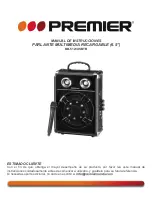
920-0437-00 Rev. A
Page 2 of 8
Sirens are an integral part of an effective audio/visual emergency warning system. However, sirens
are only short range secondary warning devices. The use of a siren does not insure that all drivers
can or will observe or react to an emergency warning signal, particularly at long distances or when
either vehicle is traveling at a high rate of speed. Sirens should only be used in a combination with
effective warning lights and never relied upon as a sole warning signal.
Never take the right of way for granted. it is your responsibility to be sure you can proceed safely
before entering an intersection, driving against traffic, or responding at a high rate of speed.
The effectiveness of this warning device is highly dependent upon correct mounting and wiring.
Read and follow the manufacturer’s instruction before installing or using this device. The vehicle
operator should check the equipment daily to insure that all features of the device operate correctly.
To be effective, sirens must produce high sound levels that potentially can inflict hearing damage.
Installers should be warned to wear hearing protection, clear bystanders from the area and not
to operate the siren indoors during testing. Vehicle operators and occupants should assess their
exposure to siren noise and determine what steps, such as consultation with professionals or use
of hearing protection should be implemented to protect their hearing.
This equipment is intended for use by authorized personnel only. It is the user’s responsibility to
understand and obey all laws regarding emergency warning devices. The user should check all
applicable city, state and federal laws and regulations.
Code 3, Inc., assumes no liability for any loss resulting from the use of this warning device.
Proper installation is vital to the performance of the siren and the safe operation of the emergency
vehicle. It is important to recognize that the operator of the emergency vehicle is under
psychological and physiological stress caused by the situation. The siren system should be
installed in such a manner as to:
A) Not reduce the acoustical performance of the system.
B) Limit as much as practical the noise level in the passenger compartment of the vehicle.
C) Place the controls within convenient reach of the operator so that he can operate the system
without losing eye contact with the roadway,
Emergency warning devices often require high electrical voltage and/or currents. Properly protect
and use caution around live electrical connections. Grounding or shorting of electrical connections
can cause high current arcing, which can cause personal injury and/or severe vehicle damage,
including fire.
PROPER INSTALLATION COMBINED WITH OPERATOR TRAINING IN THE PROPER USE OF
EMERGENCY WARNING DEVICES IS ESSENTIAL TO INSURE THE SAFETY OF EMERGENCY
PERSONNEL AND THE PUBLIC.
!
WARNING!


























